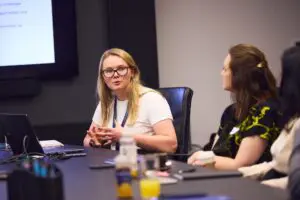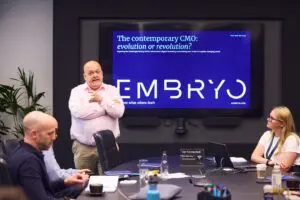
The paid media landscape in 2024: What senior marketers need to know

In May, Embryo hosted some of the country’s most experienced marketers for a 2-day conference. Here, we’ve summarised the update we presented about our take on today’s paid media landscape, and what senior marketers need to know.
The landscape in 3 words
Throughout this article, three core themes span platforms and advertising formats. They present both challenges and opportunities for marketers and advertisers, as well as decisions to be made at a senior level regarding where to invest marketing resources:
- Broad: broad targeting, and rounded strategies beyond a platform’s usual remit
- Salience: as targeting options are taken away, ad creativity is ever important, as well as a brand’s ability to be relevant to its audience
- Measurement: continued challenges stemming from limitations in reporting and measurement
What’s changed: campaign structures
Historically, what worked was granular campaign structures – such as single-keyword ad groups (SKAGs) – all managed through manual interventions, painstakingly optimised individually. Now, we see success through consolidated campaign structures, with a higher volume of advertising asset variants, all underpinned by, and dependent on, data and machine learning.
The consideration now is that the advent of ‘giving control back’ to the ad platforms puts ever more onus on identifying the correct objective for your campaign: what are you asking the platform to achieve for you? Given that the algorithms require data to learn and optimise, the quality and hygiene of what they’re being ‘fed’ is equally important. Having paid media teams – whether in-house or agency-side deeply in sync with your business and marketing strategy has never been more important.

PPC moves up the funnel
Within PPC, there’s been a further move to multi-network campaign types – resulting in integrated, full-funnel advertising being available within a single platform. We saw this first with Performance Max, which rolled out in 2021, where Google combined placements across Search, Shopping, and display-based channels including YouTube. This has since been joined by Demand Gen, which targets predominantly upper-funnel audiences.
One of the primary differences with these campaign types, compared to the traditional separated campaigns, is the degree of control for the advertiser is reduced. Using its machine learning models, Google makes its own decisions about where to place ads, and to whom. Naturally, there are some ‘guardrails’ that advertisers can put in place (such as geographical exclusions), but until fairly recently, insight and granular reporting as to precisely where ads were being shown wasn’t forthcoming.
Bringing in the wider marketing strategy
Google Ads is also now taking into account the holistic online shopping experience that your brand provides, through factors such as Google Merchant Centre’s pricing benchmarking (how price-competitive you are in the market), and shopper experience – which considers shopping hygiene factors such as delivery and returns.
This is evidence of success on these platforms continuing to be affected by drivers beyond the ad-level experience, and into your wider marketing strategy
We continue to see the rise of authenticity in content and how users engage with brands. User-generated content is being utilised by more and more brands – even within the luxury space, which typically favours a highly polished aesthetic. Similarly, stripped-back pieces to cameras in FAQ format are working effectively for service-led industries such as financial services.
For the marketing leadership team, this presents an opportunity to test these (often lower-cost) forms of video – as long as your business possesses a willing ‘face’ to appear on camera!
Targeting on platforms such as Meta is moving away from the long lists of interest and demographic targeting options, and into the concept of “guidance over requirements” when it comes to serving ads. Again using data to determine who’s most likely to carry out the required conversion action.
However, something to bear in mind when new features are released is to continue to test against what’s performed historically for your brand. Ad platforms may often stimulate the adoption of new products and functionalities by engineering strong results, which, to begin with, aren’t sustained as you scale. Controlled roll-out of these is advisable, especially when your marketing mix relies heavily on paid channels.

What about AI?
It would be remiss to create a round-up of anything digital marketing-related in 2024 without a nod to AI. However, our view on AI for paid media is that it’s not quite the revolutionary brand-new phenomenon that it’s made out to be in other spheres. AI has been ‘a thing’ in paid media for some time, although it’s not explicitly been termed as such, through machine learning, and the use of data sets to make automated decisions for targeting and bid management.
So what are the opportunities? Generative AI can support asset creation and ad copy, as well as suggest account-build structures. A strong use case is in using AI to support data analysis, though this does bring a warning about uploading potentially sensitive company data into an AI tool.
This all leads to the question of if you had more time, what should you do with it? For marketing leaders, how can existing skills and colleagues be better harnessed and allocated, to higher-value tasks, if the ad platforms do much of the heavy lifting themselves?
How measurability is changing
Finally, to the ever-present question of what happens when third-party cookies are totally phased out (and when will Google stop putting this off). Ultimately, this is something that’s still being worked out, even by the largest tech companies themselves. Meta has never fully recovered from iOS14.5-gate, despite ad revenue being its primary income source.
The key consideration for marketers at present is how they can best mobilise their first-party data sources, to build a picture of audiences, and provide ad platforms with data they wouldn’t have otherwise been able to collect – such as through the use of offline conversion tracking.
After the ‘golden age’ of digital marketing – where every penny outlaid in advertising could be traced to a purchase or visitor – a combination of legislative changes, and public sentiment towards tracking, will result in a very different landscape to what we’ve known before.
This will likely result in having to work with modelled data (rather than 100% actual), and potentially changes in investment and channel mixes – will we see a return to brand investment where performance had previously taken a larger share? Ultimately, it will become necessary to be comfortable with less detail – something that requires significant organisational expectation management for many businesses, with senior stakeholders accustomed to the granularity of reporting that’s been enjoyed historically.
The bottom line
For marketers whose channel mix relies heavily on paid media, it undoubtedly feels like a very uneasy time. Amongst all of the changes above, the saturation on, and limited levers within, ad platforms, it no longer feels like you can gain a competitive edge ‘simply’ by having a solid paid media strategy. Instead, I’d suggest that success will be reliant on three key factors:
- First-party data management and availability: what are you able to feed back into ad platforms?
- Customer insight and understanding: to inform your creative, messaging and platform choices
- Your overall channel mix: an over-concentration on one channel poses a greater business risk than ever before. Is diversification in your roadmap for 2024?


